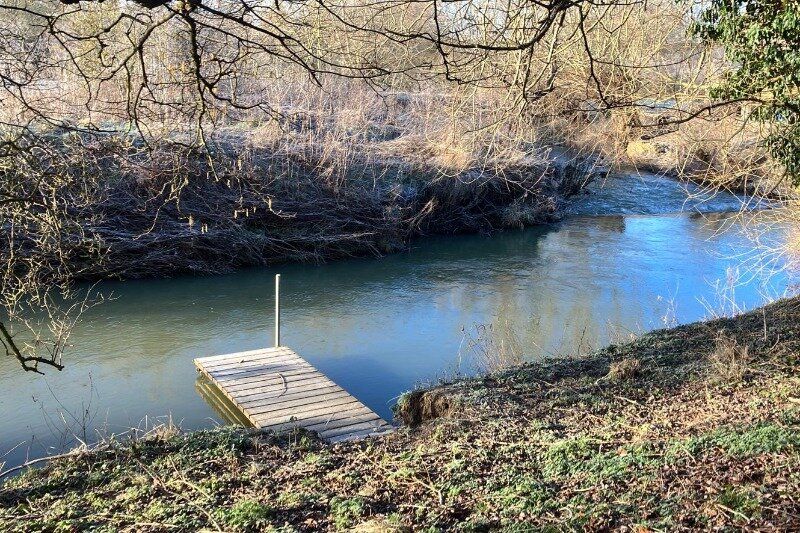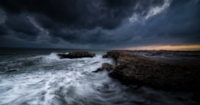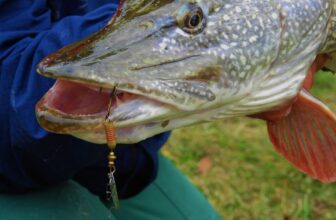Pike are the dominant predator in UK waters and have an almost legendary status for being the most exciting fish to target in our little isle. Thanks to pike’s aggressive nature and size – they’ve been known to reach more than 40lbs in UK waters – they’re a rite of passage for any coarse fishing angler.

But despite all of this pike fishing tends to be for more serious anglers, and with good reason. Pike are most active when the water temperature drops after the summer and the dissolved oxygen levels in the water increase. The fish begin to seriously feed in the autumn months right through until the spawning season in March. Coinciding with the coarse fishing close season.
So the prevailing wintery conditions, sharper teeth and surprisingly delicate nature of the fish make pike a fish for the serious angler. Buddy up with someone more experienced to begin with and you’ll be good to go.
The 22 Best Pike Fishing Tips
Table of contents
What is a pike?
A pike is a pointy, long-bodied predatory fish of the genus Esox native to both Eurasia and North America. This species of carnivorous fish is commonly found in both brackish and freshwater bodies of water in the Northern Hemisphere and has been known to eat fish, rodents, birds and snakes.
A hugely popular fish for anglers in UK waters thanks to their powerful strike and prevalence in the autumn and winter months.
How do you start pike fishing?
To start pike fishing you need to have six key things:
- A location
- Pike fishing tackle
- Pike care equipment
- As a beginner, somebody more experienced to go with
- A basic understanding of watercraft
- A fishing license
Location-wise you can fish for pike in both rivers and stillwaters depending on the time of year and whether the body of water you’re fishing is impacted by the coarse fishing close season. Tackle-wise a rod, reel, wire trace and 20lb + line are as essential as the lures or baits you need alongside the landing mat and fishing net required.

As a beginner, it’s essential you go with somebody with some experience. For your own safety – pike’s teeth are very sharp and they’re aggressive – and the pike’s.
Of course, you also need a basic understanding of pike-specific watercraft. Where is the pike most likely to be? What’s going to entice it? And how can I catch it. Finally of course, a fishing license. Don’t overlook a license. Fines can be substantial and the money goes to ensuring coarse fishing in the UK is kept to a certain standard.
Pike are surprisingly brittle fish that can engorge the lure or bait whole, so you need to understand how to handle the pike safely and efficiently. Don’t put the fish at risk.
When is the pike fishing season in the UK?
Whilst there’s no specific pike fishing season, the autumn and winter months from September / October – March 14th, when the coarse fishing season ends in the UK tend to be the most prolific. However, you can still fish the majority of canals and stillwaters during the close season, just be sure to check the rules and regulations assigned to each body of water.
Pike spawn between March and May each year and the coarse fishing close season is designed to protect fish stocks, particularly in their spawning season.
When should I start pike fishing?
Outside of the coarse fishing close season on all rivers, streams and certain sections of canals, you can fish for pike year-round. The autumn and winter months tend to be most prolific when it comes to pike fishing as the water temperature drops, oxygen levels rise and the pike becomes more active.
Pike are fish that tend to suffer in the warmer summer months when oxygen levels are low as they suffer from a lactic acid buildup and become sluggish. Catching a gassed-up pike can feel like hauling in a deadweight.
if you’re lure fishing for pike then the autumn months tend to be more prolific. However when the water temperature reaches a certain point – traditionally in the single figures – pike become much more sedentary as they prioritise conserving energy. At this time of year, you’ll need to locate the fish.
The time of year you’re fishing for pike and the conditions impact on the manner in which you should fish for pike. When winter really sets in and the pike’s metabolism slows substantially fishing with live bait tends to be more effective than dead bait or lures.
How do you catch pike?
There are three main tactics when it comes to catching pike: deadbaiting, live baiting and lures. The method you choose should be dictated by the time of year, location and weather conditions.
- Deadbaits: The perfect conditions for fishing for pike with deadbaits are mild temperatures, overcast, low-pressure days. Oily sea fish like mackerel tend to be the live bait of choice for pike anglers. But lighter-scented fish like smelt are an equally good option.
- Livebaits: Any coarse fish can be effective when live baiting and it tends to add the most value in colder water when pike are at their most sedentary as it can encourage the pike to strike.
- Lures: Tend to be most effective in the slightly warmer months when the pike are more active and at their most aggressive. Late summer / early autumn in the September and October months tend to provide the best conditions for pike lure fishing.
Not all fisheries will allow live baiting – and for good reason. Whilst there are ethical considerations when it comes to live baiting, some fisheries will only only baits purchased from them. This is to prevent disease from entering the water.
The 10 Best Pike Fishing Lures in 2023 Editor’s choice
What is the easiest way to catch pike?
This does depend on the prevailing weather conditions, the body of water you’re fishing and your knowledge of the area. When the water has dropped substantially in temperature pike are less aggressive and more lethargic, on the lookout for an easy meal. In these situations deadbaits are arguably your best chance of success. Although live baiting can entice the fish more effectively. Just make sure it;s allowed in your area.

If you are fishing a river or stillwater you’ve never fished before, then spending time lure fishing covering the area is a great way to understand where the pike are likely to be. Once you know where the pike are more likely to be, then chumming the area with some small chunks of bait is a good idea before you start deadbaiting. Which is arguably the most effective way to catch pike.
Lure fishing is also an incredibly effective way to catch pike typically in the autumn / early spring months when pike are more aggressive, both defending their territory and hunting. The other oft-overlooked benefit of lure fishing for pike is that the pike are less likely to get deep hooked, because you’re able to strike much faster.
What time of year is best for pike fishing?
Typically the winter months yield the best opportunities to catch the biggest pike. Post the low oxygen summer months the pike begin to wakeup and feed once the lactic acid buildup in their system begins to drop. Whilst the particularly cold months foster a more sedentary lifestyle in order to save energy, wild pike will rarely pass up a meal.
But the autumn months can be really prolific when it comes to targeting jack pike on lures and you can catch pike all year round. Particularly if they’re aggressive of hungry.
What Is The Best Weather For Fishing?
What time of day are pike most active?
A pike’s metabolism – and as such its activity – is directly linked to the water temperature. The time of day they’re most active varies with temperature, pressure and sunlight. But as a general rule of thumb:
- Pike tend to be most active in the early morning as the sun warms the water and at dusk
- When conditions are too clear they won’t feed as effectively
- If the water is too cold then pike will be more sedentary and search out deeper water
How do I find the pike?
In both stillwaters, canals and rivers pike tend to inhabit areas that provide cover. Structure, heavily weeded areas and features like ledges, canal boats. trees or underwater islands are all excellent. For both pike and its prey.

In the warmer autumnal months you’ll find pike tend to live in water that is 3 – 6 feet deep. However, in the colder months they withdraw to deeper stretches of water that retain heat more effectively than the surface area. This could be anywhere as deep as 15 – 20 feet depending on the body of water.
In rivers and moving bodies of water you need to look for deeper pools of slack water. Pike are not fish that live in the current, preferring to conserve their energy by finding deeper pools of slack water concurrent to fast-flowing water where smaller baitfish live.
If there are no obvious pools of slack water in the river you’re fishing then look for larger bends in the river. Water movement is slower on the inside of a bend and you can find pools of slack water in these areas that is perfect for larger predators to lie in wait.
What kind of bait do pike like?
Pike are typically unfussy when it comes to bait. For most anglers, the deadbait of choice tends to be oily, pungent sea fish like mackerel or sardines. Particularly in less-fished rivers where the water conditions are cloudier than in traditional stillwaters. However, oily fish are not always better and stillwater pike can become wary of certain baits. So if you feel like mackerel ha become an overused deadbait, lighter-smelling fish like smelt or roach are good choices.
But it doesn’t end at fish. Pike will eat other pike, birds, squid and even rodents. The below video of The Ginger Fisherman shows a huge 20lb+ urban canal pike being caught on a dead rat. One of our all time favourite pike lures is the humble frog. Find an area with lilies, or surface cover where a frog could conceivably live and trot the frog across the top.
What depth should you fish for pike?
The depth you should fish for pike entirely depends upon the season, weather conditions and the body of water you’re fishing in. But as a general rule of thumb in stillwaters:
- In warmer temperatures pike will live in shallower waters, around 3 – 6 feet deep
- In colder conditions pike will seek out the deeper pools of warmer water, less affected by external temperatures. This can be as deep as 15 – 20 feet in lakes.
- For example, prior to the first frost setting in, you’ll find pike in shallower, weedy pools where they can hide from baitfish
In rivers pike tend to be more consistent and will typically stay in and around the same location, conserving energy to hunt. So any deep pool of slackwater or structure and baitfish-rich area is likely to be a good option all year-round. Just remember to have a couple of backups at the ready.
Do pike stay in the same area?
Whilst pike do tend to stay in the same area, where the fish congregate in is governed by the prevailing weather conditions. As previously discussed In the summer months pike you’ll typically find pike in shallower warmer water. Whereas in the winter months they’ll move to deeper, warmer spots.
Smaller pike will usually avoid larger pike on account of two things. The species’ cannibalistic tendencies and the fact that larger pike will steal food from smaller pike. So if you’ve come across some smaller jack pike and you’re after a big-un, moving on is a good idea.
Are pike territorial?
Yes pike are territorial fish. When the water is warm enough and the dissolved oxygen levels are higher, pike will attach just about anything that goes into its home. This is what makes fishing for pike with lures such an exciting prospect. As a general rule the larger the pike the larger its territory.
FAQs
Is March good for pike fishing?
March is not a particularly good month to fish for pike for two reasons. In the UK pike typically begin to spawn between March and May. As such pike are less focused on feeding and more focused on the survival of their species. Combine this with the coarse fishing close season and you can only fish for half the month.
How do you catch pike in February?
February tends to be an excellent month to fish for pike in the UK because the temperatures are cooler and pike are looking to put on weight prior to their spawning season. Whilst the water temperature can make the fish a little lethargic, February tends to be an excellent month for dead or live baiting.
Can I catch pike all year round?
Yes you can catch pike all year round but there are certain restrictions – both legislative and angling quality specific – that you need to be aware of.
The coarse fishing close season runs between March 15th – June 15th, as such all moving bodies of water, certain stretches of canals and compliant stillwaters shut to allow fish stocks time to recover. And pike fishing tends to be an autumnal / winter pastime. Although you can still catch pike in summer, it’s less likely.
Is pike fishing good at night?
Pike fishing is less prevalent at night for the simple reason that pike are sight hunting fish. Although their eyesight is half as good as the common perch.
However pike have been known to feed at night and like with most species it tends to be the larger fish that feed at this time. As a general rule of thumb an hour or two either side of dusk and dawn tend to provide the best opportunity.
Are pike hard to catch?
This does depend on the time of year, the prevailing conditions and your ability to find the fish. If you’re targeting wild pike on a warm, sunny, high pressure summer’s day pike fishing can be incredibly difficult. If not nigh on impossible.
However once you’ve found the pike and have a variety of baits and lures available to you, pike fishing can be relatively easy thanks to the pike’s aggression. They are territorial fish that won’t just attack out of hunger, but as a way of showing dominance and protestng their territory.
Does pike feed in the morning?
Yes pike do fish in the morning. In fact the morning is typically the best time to fish for pike. An hour or two either side of sunrise and then again at sunset tends to be when the pike are most active, although the prevailing weather conditions and pressure will play a factor.
Stillwaters tend to create more consistent feeding patterns than rivers. River pike tend to be more aggressive throughout the day, whereas stillwater fish tend to feed at the same times day in and out.
Is pike fishing good after rain?
Rain doesn’t tend to have consistent negative or positive effect on pike fishing, unless the rain is heavy enough to cause water levels to rise or it is perceived to scramble a pike’s sensory perception. Which can – theoretically – make lure fishing tricky.
As pike rely on their eyesight to hunt, conditions that reduce visibility can only negatively impact your fishing. But if a prolonged period of rain subsides and conditions return to normal, we’d expect pike to be more active than usual.
Tags: Coarse FishingPike
Hi, I'm Harry. A keen, albeit exceedingly average fisherman. I've spent the last few years trawling London's waterways with - if I'm being kind - varied success and would love to help you avoid the mistakes I have made.









